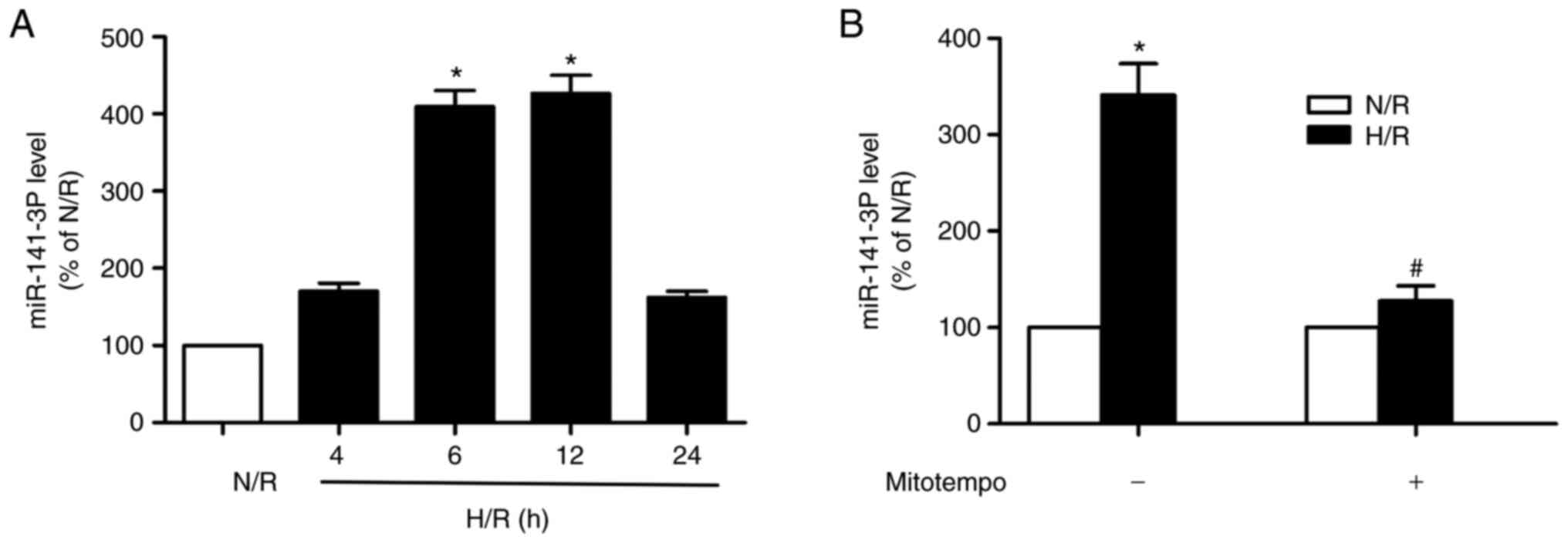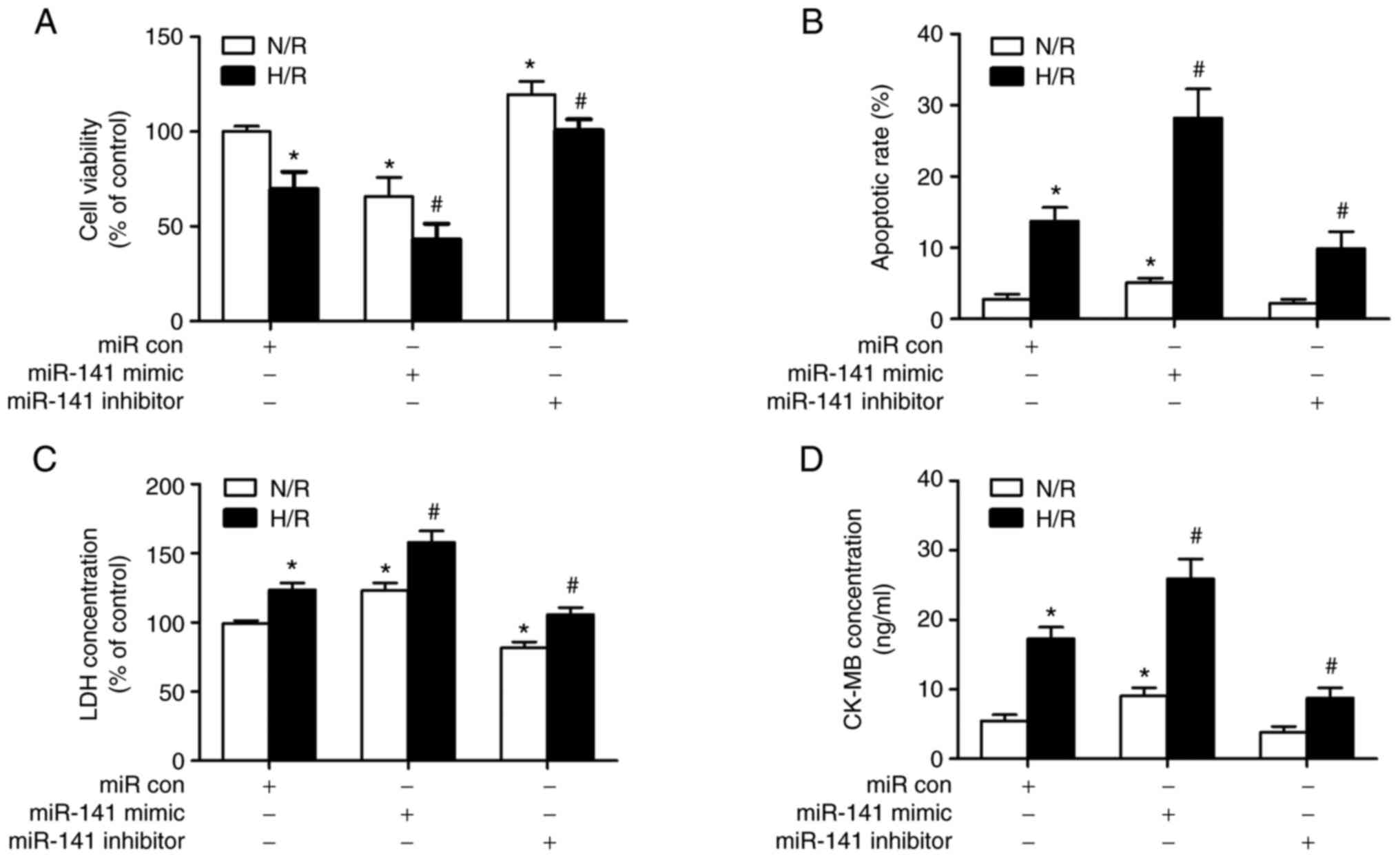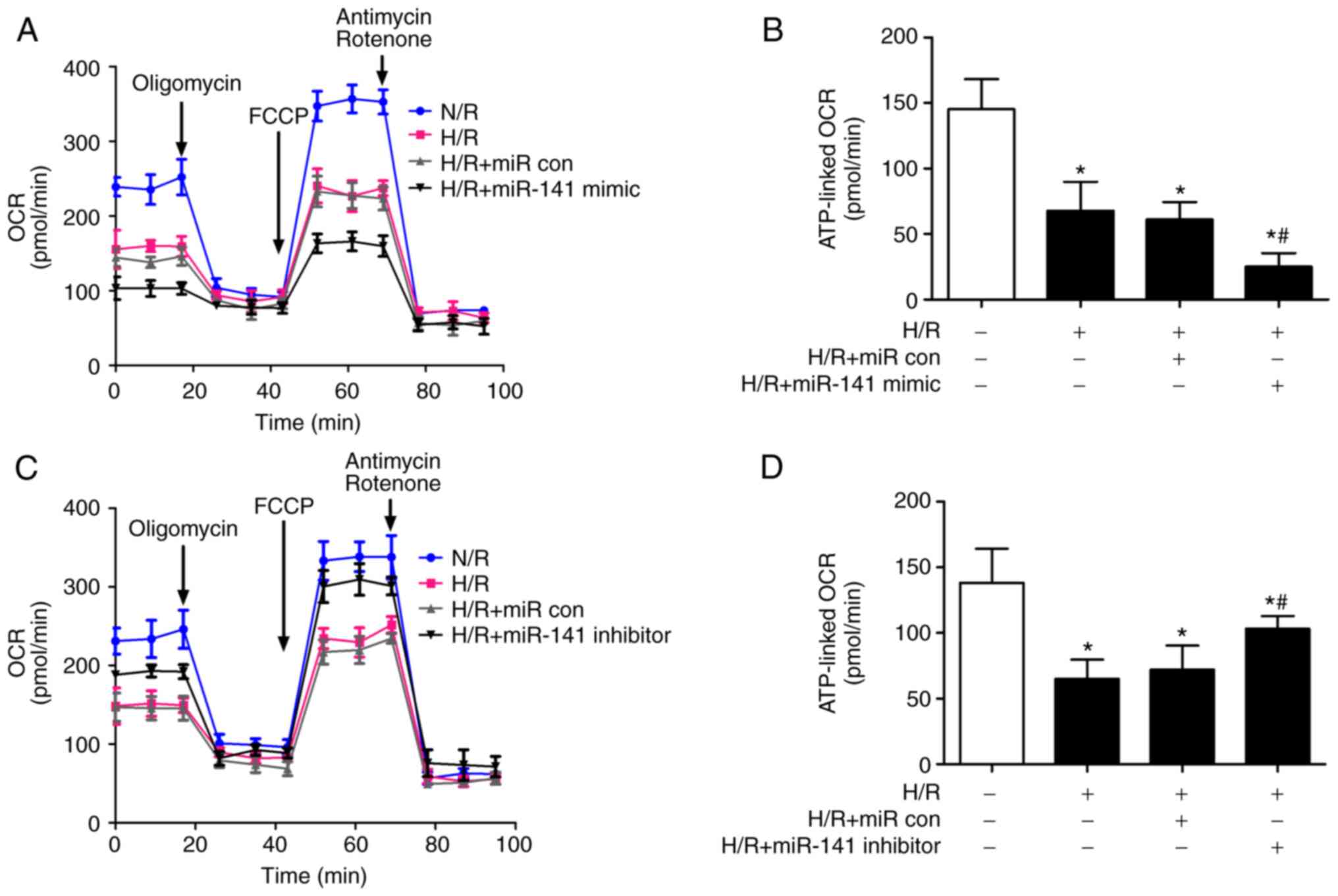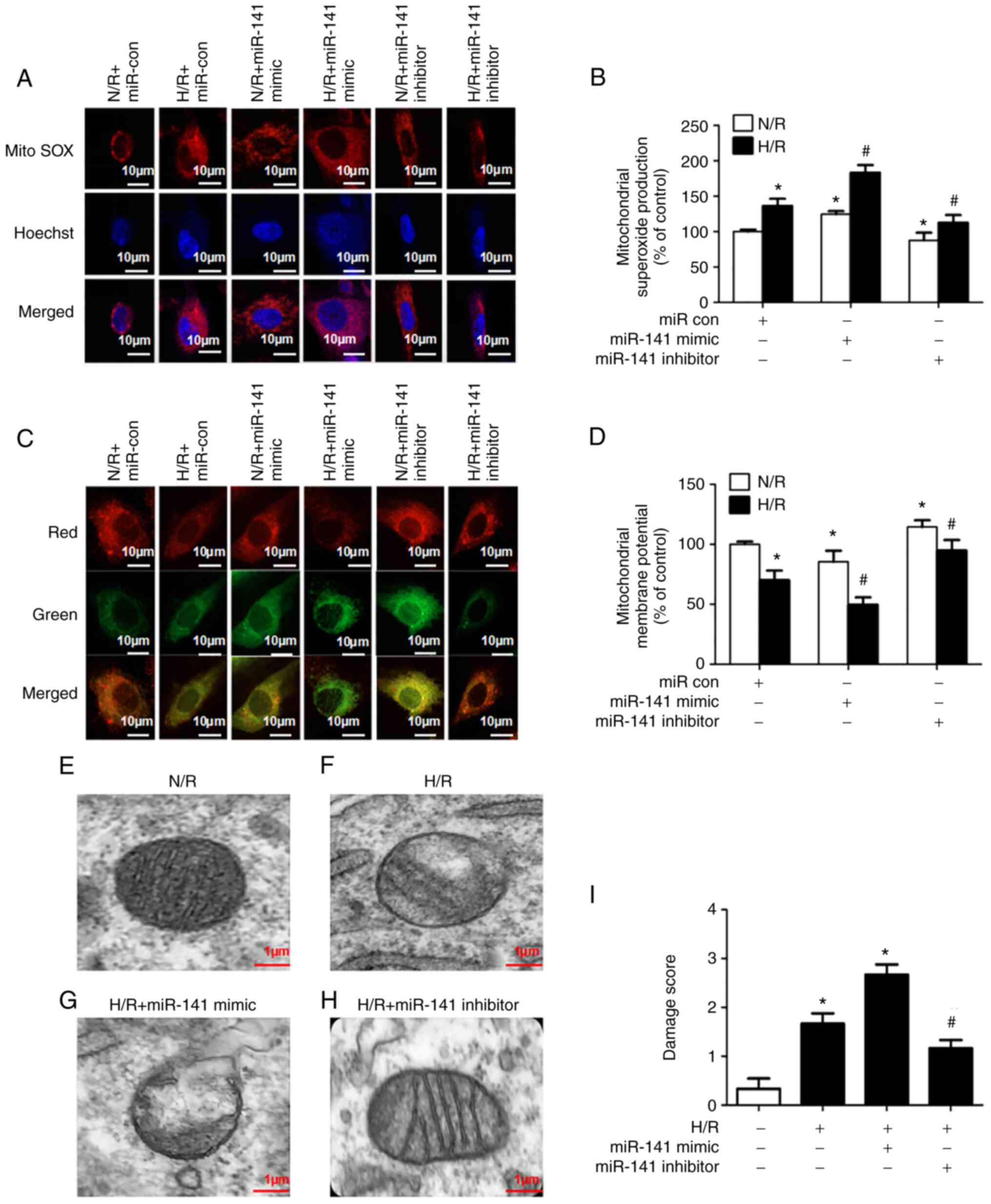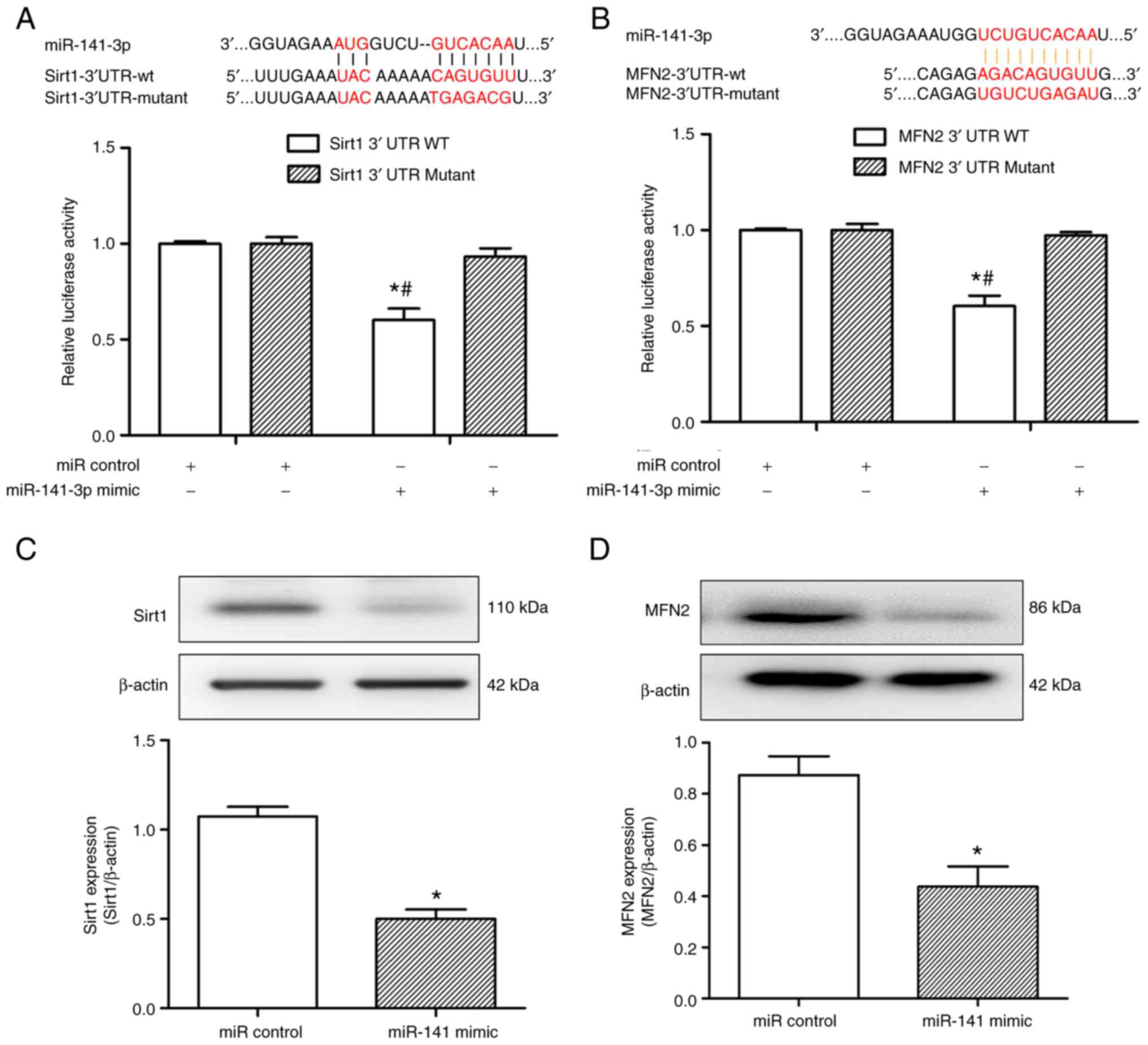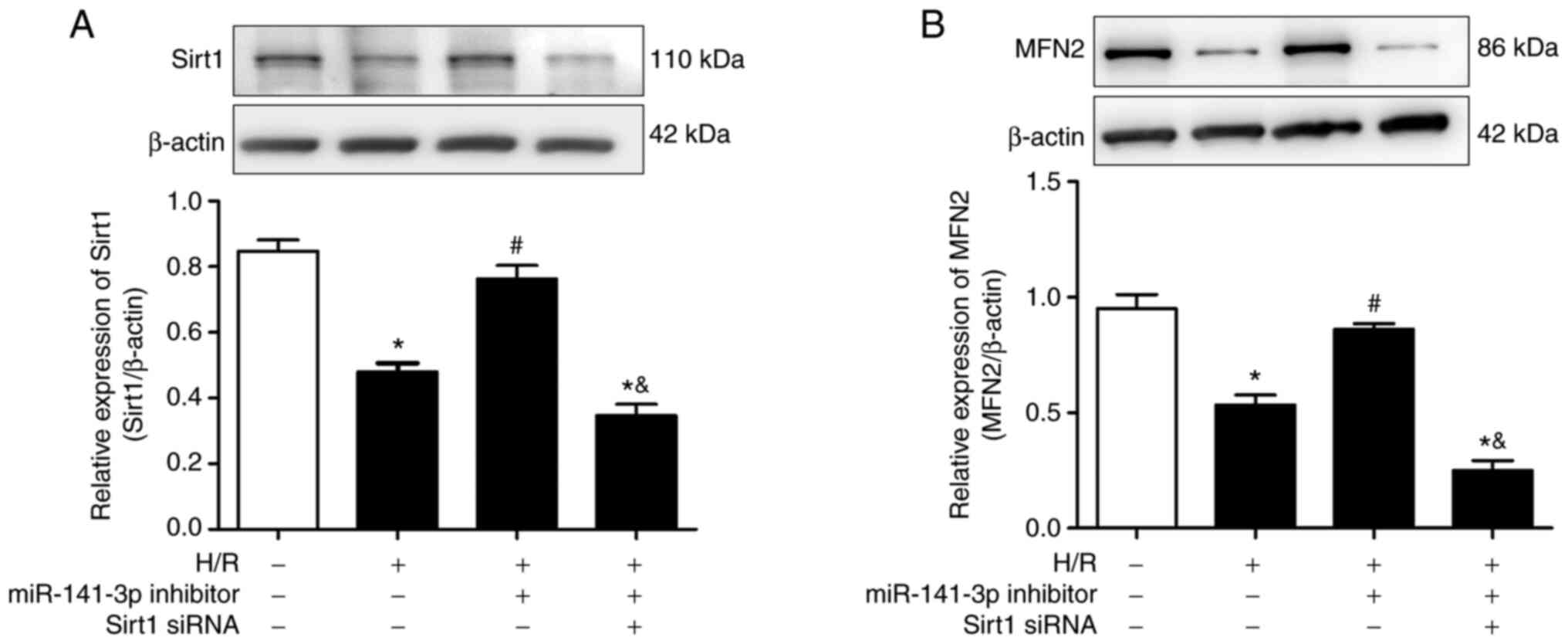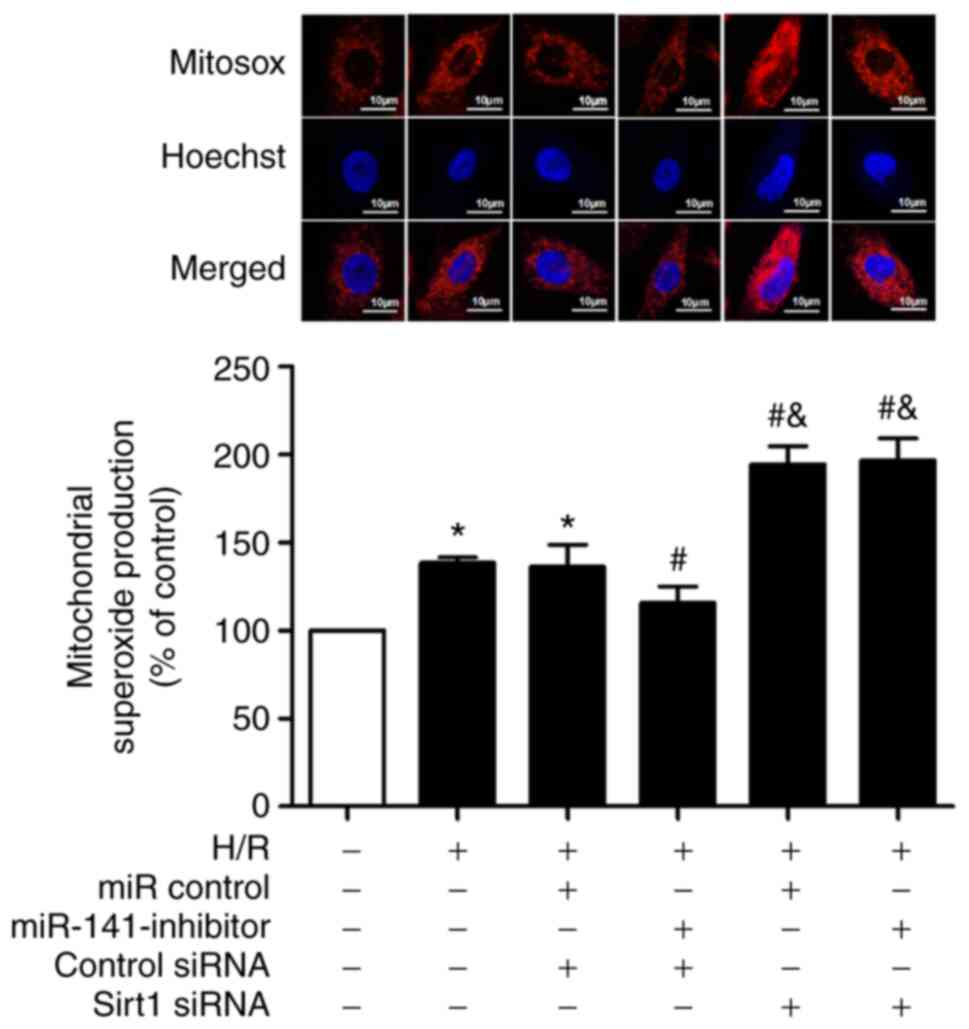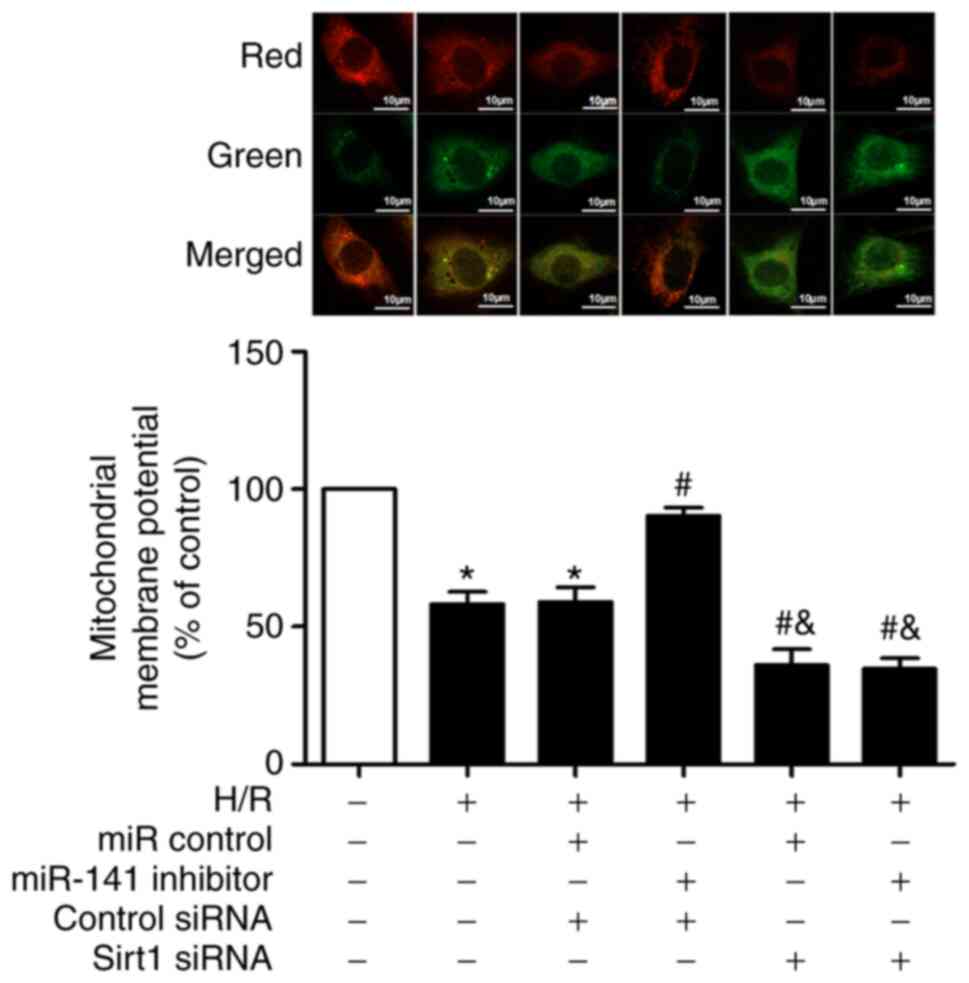miR‑141 impairs mitochondrial function in cardiomyocytes subjected to hypoxia/reoxygenation by targeting Sirt1 and MFN2
- Authors:
- Published online on: November 14, 2022 https://doi.org/10.3892/etm.2022.11699
- Article Number: 763
-
Copyright: © Zhang et al. This is an open access article distributed under the terms of Creative Commons Attribution License.
Abstract
Introduction
Myocardial injury incurred during ischemia is generally attributed to a depletion of myocyte adenosine triphosphate (ATP) production. The reperfusion of the ischemic myocardium is the only recourse to salvaging cardiac function. Paradoxically, reperfusion itself induces further tissue injury. Thus, immense efforts have been expended to gain insight into potential drivers of reperfusion injury, in order to enable the development of therapeutic strategies for the mitigation of reperfusion injury (1,2). To this end, in vivo and ex vivo models of cardiac ischemia/reperfusion (I/R) have been used. In vivo models involve occlusion and the subsequent release of a coronary artery, and tracking cardiac injury and inflammation. This approach more closely simulates the clinical situation; however, due to input from various resident (myocytes, fibroblasts, endothelial cells) and infiltrating immune (neutrophils, monocytes) cells, unravelling the cellular mechanisms is challenging (3). Frequently, cell-based models are used, involving the challenge of cardiomyocytes with hypoxia/reoxygenation (H/R).
Consensus holds that reactive oxygen species (ROS) play a critical role in reperfusion-induced cardiac injury (4-6). Whereas there are several potential sources of ROS in cardiomyocytes, mitochondrial-derived ROS are particularly attractive targets. Mitochondria most likely generate ROS during the normal course of oxidative phosphorylation. The rapid transfer of electrons along the electron transport chain (ETC) can result in the ‘leakage’ of electrons that can interact with O2 to form superoxide. A particularly devastating feature of mitochondrial ROS production is the feed-forward mechanism by which ROS-induced ROS release spreads from one mitochondrion to another, ultimately resulting in myocyte dysfunction and death (7,8).
Regulatory mechanisms are operative, to limit excessive cellular ROS levels and associated sequelae. At the transcriptional level, ROS can transactivate genes encoding enzymatic and non-enzymatic antioxidants (4,5). At the translational level, an additional layer of regulation is achieved by microRNAs (miRNAs/miRs) (9-11). miRNAs are non-coding RNAs that can modulate genetic output of antioxidants, primarily by transcriptional silencing. Members of the miR-200 family (miR-200a, miR-200b, miR-200c, miR-141 and miR-429) can respond to and regulate cellular ROS levels (9,10). Two members of this family, miR-200c and miR-141, have been implicated in various pathologies associated with excessive oxidant stress and mitochondrial dysfunction within the heart, including aging and diabetes (11,12). While an increase in miR-200c driving cardiac I/R or H/R injury has been supported by previous studies (1,2), the role of miR-141 is rather ambiguous (13,14). This is contrary to the available evidence for a ROS/miR-141 pathway being intimately involved in mitochondrial dysfunction (15-17). Thus, in the present study, a reductionist approach was applied to systematically re-examine this issue. The current findings indicate that the challenge of cardiomyocytes with H/R may result in mitochondrial dysfunction via a ROS/miR-141 pathway, in line with a ROS-induced ROS release mechanism.
To address specific targets of miR-141 that may mediate the H/R-induced mitochondrial dysfunction, the present study focused on sirtuin-1 (Sirt1) and mitofusin-2 (MFN2). Sirt1 and MFN2 both are intimately involved in mitochondrial function (18-20) and exerts cardioprotective effects in I/R models (18,21). Of note, a Sirt1/MFN2 pathway has been implicated in I/R-induced mitochondrial dysfunction in hepatocytes (22,23). Herein, evidence was provided that both Sirt1 and MFN2 have functional binding sites for miR-141 on their gene transcripts. Additionally, the blockade of miR-141 can prevent the H/R-induced downregulation of Sirt1and MFN2. Collectively, the results of the present study indicate that the ROS/miR-141/Sirt1/MFN2 pathway may promote myocardial I/R injury by inducing mitochondrial dysfunction.
Materials and methods
Reagents
Mitochondrial ROS was detected using MitoSOX (cat. no. M36008; Thermo Fisher Scientific, Inc.) and Mito-Tempo (cat. no. 1334850995; MilliporeSigma) was used to quench mitochondrial ROS. Mitochondrial membrane potential was assessed using JC-1 (cat. no. 40705ES03; Shanghai Yeasen Biotechnology Co., Ltd.).
For reverse transcription-quantitative PCR (RT-qPCR), the primers used for miRNA were 5'-TAGCCTGCTGGGGTGGAA-3' (forward), and 5'-TATGGTTTTGACGACTGTGTGAT-3' (reverse). The control primers (U6) were 5'-CGCGCTTCGGCAGCACATATACT-3' (forward) and 5'-ACGCTTCACGAATTTGCGTGTC-3' (reverse).
For western blotting, the primary antibodies used were as follows: MFN2 (1:1,000; cat. no. sc-515647; Santa Cruz Biotechnology, Inc.), Sirt1 (1:1,000; cat. no. sc-74465; Santa Cruz Biotechnology, Inc.), and β-actin (1:5,000; cat. no. 66009-1-Ig; ProteinTech Group, Inc.). A horseradish peroxidase-conjugated goat anti-mouse secondary antibody (1:2,000; cat. no. ab205719; Abcam) was used for detection.
siRNA transfection
For RNA interference, two approaches were followed: Small interfering RNA (siRNA) and miRNA. siRNA-Sirt1, as well as a miR-141-3p (miR-141) mimic and an inhibitor were synthesized by Shanghai GenePharma Co., Ltd. The target sequence for Sirt1 siRNA was 5'-CCCUGUAAAGCUUUCAGAA-3' and that of the negative control was 5'-TTCTCCGAACGTGTCACGT-3'. The sequence of miR-141 mimic was 5'-UAACACUGUCUGGUAAAGAUGG-3' and that of the negative control was 5'-UUCUCCGAACGUGUCACGUTT-3'. The sequence of the miR-141 inhibitor was 5'-CCAUCUUUACCAGACAGUGUUA-3' and that of the negative control was 5'-CAGUACUUUUGUGUAGUACAA-3'. All the siRNAs and miRNA mimics/inhibitors were transfected into the HL-1 cells (described below) using Lipofectamine 2000 reagent (cat. no. 11668019; Thermo Fisher Scientific, Inc.). Briefly, two sterilized Eppendorf tubes were prepared for each group of cells. Each tube was filled with 100 µl Opti-MEM (Thermo Fisher Scientific, Inc.). One tube was filled with 5 µl Lipofectamine 2000, whereas the other was filled with 100 pmol mimics/inhibitors/negative control or with 75 pmol siRNAs/negative controls. The two tubes were then evenly mixed and incubated at room temperature for 20 min. The cells transfected with siRNA/mimics/inhibitors were incubated in a standard incubator at 37˚C and 5% CO2 for 48 h before subsequent experiments.
Hypoxia/reoxygenation (H/R) of HL-1 cells
The HL-1 immortalized murine cardiomyocyte cell line (cat. no. SCC065; Merck KGaA) was grown in DMEM (cat. no. 11995065; Gibco; Thermo Fisher Scientific, Inc.) with 10% FBS (cat. no. 16140071; Gibco; Thermo Fisher Scientific, Inc.) and 1% penicillin/streptomycin (cat. no. 10378016; Gibco; Thermo Fisher Scientific, Inc.) at 37˚C in a standard humidified incubator (95% air/5% CO2). The H9c2 cell line was obtained from the American Type Culture Collection (cat. no. CRL-1446) and cultured in DMEM containing 10% FBS at 37˚C with 5% CO2. To induce hypoxia, the culture medium was changed to serum- and glucose-free DMEM, placed into an anaerobic chamber, wherein O2 was purged with AnaeroPack (Mitsubishi Gas Chemical Co., Inc.) for 3 h (<0.1% O2, >15% CO2). Subsequently, the cells were reoxygenated through replenishment with fresh DMEM and rapidly transferred back to the standard incubator. Cell and mitochondrial functions were evaluated at the indicated time points (6 and 12 h) following reoxygenation. As a control, HL-1 cardiomyocytes were incubated with serum- and glucose-free DMEM for 3 h under standard normoxic (20% O2) conditions at 37˚C with 5% CO2. and then replenished with fresh DMEM and cultured in normal conditions [normoxia/reoxygenation (N/R)].
Cell injury assays
Cell viability was assessed using four approaches. A Cell Counting Kit-8 assay (CCK-8; cat. no. C0038; Beyotime Institute of Biotechnology) was applied for the detection of metabolic dysfunction of live cells. Cell supernatants were evaluated for the presence of WST-8 formazan produced by dehydrogenase activity of live cells. After incubation for 2 h at 37˚C, the optical density values were detected at 450 nm. Cell apoptosis was measured using an Annexin-V/propidium iodide apoptosis detection kit (cat. no. 640914; BioLegend, Inc.). In brief, cells labelled with FITC-labelled Annexin-V, excluding propidium iodide, were quantified using flow cytometry. Flow cytometric analyses were performed using BD LSRFortessa X-20 (BD Biosciences). Flow cytometry data were analyzed by FlowJo V10 (FlowJo, LLC). As an index of cell membrane disruption, the lactate dehydrogenase (LDH) content in the cell supernatants was measured using an LDH assay kit (cat. no. A0202; Nanjing Jiancheng Bioengineering Institute). In addition, the creatine kinase-MB (CK-MB) levels in the cell supernatants were measured spectrophotometrically using standard enzyme-linked immunosorbent assay kits (cat. nos. F3500-A and F2801-B; FANKEL Industrial Co., Ltd.) and a microplate reader (800 TS; BioTek Instruments, Inc.) according to the manufacturer's instructions.
Measurement of mitochondrial ROS production
Mitochondrial ROS production was detected using MitoSOX (cat. no. M36008; Thermo Fisher Scientific, Inc.), a cationic cell-permeable probe that enters the mitochondria, is oxidized by superoxide, and fluoresces when bound to nucleotides (e.g., DNA). Cell fluorescence was assessed using a confocal scanning microscope (LSM800; Zeiss AG). The superoxide dismutase (SOD) mimetic, Mito-Tempo (cat. no. 1334850995; MilliporeSigma) was used to quench mitochondrial ROS. ImageJ software (v1.8.0; National Institutes of Health) was used to quantify the fluorescence intensity.
Measurement of mitochondrial membrane potential
The fluorescent probe, JC-1 (cat. no. 40705ES03; Shanghai Yeasen Biotechnology Co., Ltd.), accumulates in the mitochondria and exhibits a red-to-green shift in emission, which is inversely proportional to membrane polarization. The red/green fluorescence intensity ratio of the HL-1 cells was assessed using a confocal scanning microscope (LSM800). ImageJ software (v1.8.0) was used to quantify the fluorescence intensity.
Determination of mitochondrial function
The mitochondrial oxygen consumption rate (OCR) of the HL-1 cells was assessed using an extracellular flux analysis using Seahorse XF Cell Mito Stress kits (Agilent Technologies, Inc.). The OCR of the HL-1 cells (1x104 cells/well) under various conditions (e.g., ETC inhibitors) was quantified in a Seahorse XFp analyzer using accompanying software (Seahorse Bioscience; Agilent Technologies, Inc.). Various compounds were used to alter mitochondrial ETC function at 37˚C: oligomycin (1 µM, 27 min) to inhibit complex V, carbonyl cyanide-p-trifluoromethoxyphenylhydrazone (1 µM, 27 min) to uncouple oxidative phosphorylation, and a combination of antimycin A/rotenone (1 µM/100 nM, 27 min) to inhibit complexes I/III.
Transmission electron microscopy
The HL-1 cells were prefixed in 2.5% glutaraldehyde (cat. no. P1126; Beijing Solarbio Science & Technology Co., Ltd.) overnight at 4˚C, washed with 0.1 M sodium cacodylate buffer (cat. no. 20840; Sigma-Aldrich; Merck KgaA) and then fixed in 1% osmium tetroxide (cat. no. 18459; Ted Pella, Inc.) for 24 h at 4˚C. The cells were then washed with 0.1 M sodium cacodylate buffer again, dehydrated in an ethanol series, infiltrated with PolyBed epoxy resin (cat. no. GP2001; Wuhan Servicebio Technology Co., Ltd.) and stained with 2% uranyl acetate (Wuhan Servicebio Technology Co., Ltd.) for 10 min and lead citrate (Wuhan Servicebio Technology Co., Ltd.) for 5 min at room temperature. Ultrathin sections were observed under a transmission electron microscope (HT7800; Hitachi, Ltd.). The extent of mitochondrial and cellular pathology was scored using a modification of previously published paradigms (24,25), with 0 assigned to intact mitochondria and 3 to severely damaged mitochondria (Table SI).
Dual luciferase assay
miRanda (http://www.bioinformatics.com.cn/local_miranda_miRNA_target_prediction_120), Tarbase (http://microrna.gr/tarbase/) and TargetScan (www.targetscan.org/vert_72/) were used to predict target genes of miR-141. MFN2 and Sirt1 were identified as potential target genes. The wild-type 3'-UTR and the miR-141 ‘seed’ mutant 3'-UTR of MFN2 and Sirt1 were synthesized in vitro and cloned into the psi-CHECK2 (Hanbio Biotechnology Co., Ltd.). luciferase reporter plasmid. 293T cells (cat. no. 12022001; MilliporeSigma). were transfected with psi-CHECK-2 plasmid containing wild-type or mutant derivatives, along with the miRNA control or miR-141 mimic using Lipofectamine 2000. After 24 h, the cells were harvested, lysed, and the ratio of Firefly luciferase to Renilla luciferase was assessed. The luciferase activity was detected using the Dual Luciferase Reporter Assay kit (Promega Corp.). The psi-Check2 vector was used for the dual luciferase assay. In this vector, the promoter of Firefly luciferase (Fluc) is sv40, and the promoter of Renilla-luciferase (Rluc) is HSV-TK. The binding site region were constructed in the 3'UTR region of Fluc.
RT-qPCR
Total RNA, including miRNA, was extracted from the cultured cells by using Trizol reagent (cat. no. B511311; Sangon Biotech Co., Ltd.). The target miRNA was reverse transcribed into cDNA using the miRNA 1st Strand cDNA synthesis kit (cat. no. MR101-01; Vazyme Biotech Co. Ltd.). The miRNA expression level was determined with a miRNA Universal SYBR qPCR master mix (cat. no. MQ101-01; Vazyme Biotech Co. Ltd.) using the CFX96 Touch Real-Time PCR Detection System (Bio-Rad Laboratories, Inc.). The cycling conditions are listed as follows: Pre-denaturation at 95˚C for 5 min, followed by 40 cycles at 95˚C for 10 sec and 60˚C for 30 sec, and elongation at 95˚C for 15 sec and 60˚C for 60 sec. The relative fold expression of the target, normalized to the corresponding control, was calculated by the comparative 2-ΔΔCq method (26).
Western blotting
HL-1 cells were lysed with ice-cold RIPA lysis buffer (cat. no. P0013E; Beyotime Institute of Biotechnology). BCA protein assay kit (cat. no. P0012; Beyotime Institute of Biotechnology) was used for protein quantification. Equal amounts of protein (20 µg) from each sample were separated using 10% SDS-PAGE and subsequently electro-transferred on to nitrocellulose membranes (cat. no. FFN08; Beyotime Institute of Biotechnology). Following blocking with 5% skim milk powder in 1X Tris-buffered saline containing 0.1% Tween-20 for 2 h at room temperature, the blots were probed with primary antibodies (as aforementioned) overnight at 4˚C. Subsequently, the membrane was incubated with horseradish peroxidase-conjugated secondary antibody (as aforementioned) for 1 h at 37˚C. The immunoreactive proteins were visualized using enhanced chemiluminescence reagent kit (cat. no. P0018M; Beyotime Institute of Biotechnology)and analyzed using ImageJ software (v1.8.0). β-actin served as the loading control to normalize relative protein expression levels.
Statistical analysis
Data are presented as the mean ± standard error of the mean (SEM). An unpaired Student's t-test was performed for direct two-group comparisons and one-way ANOVA was performed for multiple group comparisons followed by the Bonferroni test when ANOVA found a significant F-value and there was no variance in homogeneity; otherwise, Tamhane's T2 post hoc test was used. All statistical analyses were performed using SPSS 13.0 statistical software (SPSS, Inc.). P<0.05 was considered to indicate a statistically significant difference.
Results
H/R increases miR-141-3p expression in HL-1 and H9c2 cardiomyocytes and this event is prevented by quenching mitochondrial superoxide
The challenge of HL-1 cardiomyocytes with H/R increased miR-141 expression within 6 h following reoxygenation. The increment in expression remained elevated at 12 h following reoxygenation and returned to control (normoxia) levels by 24 h (Fig. 1A). Mitochondrial superoxide production is implicated in the I/R-induced myocardial injury (4-6). Thus, a SOD mimetic (Mitotempo) targeting the mitochondria, was used to address the role of mitochondrial ROS in the upregulation of miR-141 expression induced by H/R challenge of the cardiomyocytes. As depicted in Fig. 1B, the SOD mimetic prevented the increase in miR-141 expression at 6 h following reoxygenation. In addition, similar results were observed in H9c2 cells (Fig. S1).
miR-141-3p modulates cardiomyocyte viability following H/R
As shown in Fig. 2 (for HL-1 cells), Fig. S2 (for HL-1 cells) and Fig. S3 (for H9c2 cells), gain- and loss-of-function approaches (miR-141 mimic and inhibitor, respectively) were used to systematically evaluate the role of miR-141 in cardiomyocyte viability following H/R. Firstly, the dehydrogenase activity of live cells was measured, using a CCK-8 assay. As depicted in Figs. 2A and S3A, H/R impaired this index of cell activity. The miR-141 mimic exacerbated the effects of H/R, while the miR-141 inhibitor exerted protective effects. For the N/R of the challenged cells, the miR-141 mimic impaired cell activity, while the miR-141 inhibitor exerted protective effects. Subsequently, using differential Annexin-V/propidium iodide staining, the apoptotic cells were detected. H/R increased the number of cells in early apoptosis; this effect was exacerbated by miR-141 mimic and ameliorated by miR-141 inhibitor (Figs. 2B and S2). Late apoptotic or necrotic cells were also detected following H/R, as indicated by LDH (Figs. 2C and S3B) and CK-MB (Figs. 2D and S3C) release into the supernatants. miR-141 mimic exacerbated the effects of H/R, while miR-141 inhibitor exerted protective effects (Figs. 2C and D, and S3B and C). Establishment of the miR-141 mimic and inhibitor models was shown in Fig. S4.
miR-141-3p modulates the mitochondrial cardiomyocyte OCR induced by H/R
A metabolic flux analysis was performed to assess the mitochondrial function of cardiomyocytes challenged with H/R. Specifically, the OCR of the HL-1 cells was measured during the pharmacological modulation of the mitochondrial ETC. The challenge of the cardiomyocytes with H/R reduced their basal OCR; the miR-141 mimic exacerbated (Fig. 3A), while the inhibitor ameliorated (Fig. 3C) the decrement of basal OCR. The inhibition of ATP synthase with oligomycin revealed the ATP-linked OCR of HL-1 cells. The OCR attributed to mitochondrial ATP production was reduced in cells subjected to H/R; the miR-141 mimic exacerbated (Fig. 3B), while the miR-141 inhibitor (Fig. 3D) blunted the decrement in ATP-coupled OCR.
miR-141-3p modulates mitochondrial superoxide production, membrane potential and damage induced by H/R
The scanning confocal microscopy of the HL-1 cells was used to monitor fluorescent markers of mitochondrial superoxide (mitoSOX) and membrane potential (JC-1). Upon the reoxygenation of hypoxic cardiomyocytes, there was an increase in mitochondrial superoxide production; miR-141 mimic exacerbated, while the miR-141 inhibitor prevented the H/R-induced generation of superoxide (Fig. 4A and B). The challenge of the HL-1 cells with H/R depolarized the mitochondrial membrane; miR-141 mimic exacerbated, while the inhibitor prevented membrane depolarization (Fig. 4C and D).
Mitochondrial morphology was examined using electron microscopy (Fig. 4E-H) and the results were quantified (Fig. 4I). The normoxic HL-1 cells exhibited discernable mitochondrial membranes and cristae (Fig. 4E). The mitochondria of cells subjected to H/R exhibited signs of structural derangement; they appeared swollen and many lacked defined cristae (Fig. 4F). The miR-141 mimic aggravated the H/R-induced mitochondrial damage, additionally resulting in cell lysis in some cases (Fig. 4G). By contrast, the miR-141 inhibitor partially protected the cells from H/R-induced mitochondrial injury (Fig. 4H).
Sirt1 and MFN2 mRNA are targets of miR-141
Sirt1 and MFN2 have been reported to be depleted in hepatocytes challenged with H/R (22). miRNA target predictor programs (miRanda, Tarbase and TargetScan) identified putative binding sites for miR-141, concurrently on Sirt1 and MFN2 transcripts. To determine whether miR-141 is able to bind to either the 3'-UTR of Sirt1 or MFN2, a luciferase assay was performed. As demonstrated in Fig. 5A and B, co-transfection with miR-141 mimic decreased the relative (Firefly/Renilla) luciferase activity of 293T cells transfected with the 3'-UTR of Sirt1 or MFN2, which was not observed in the control sample. According to the binding data, the transfection of HL-1 cells with the miR-141 mimic but not with the miR control, simultaneously decreased Sirt1 and MFN2 protein expression (Fig. 5C and D). Collectively, these findings indicate that miR-141 can bind to the 3'-UTRs of both Sirt1 and MFN2, and decrease their cellular protein levels.
miR-141 inhibitor prevents the H/R-induced downregulation of Sirt1 and MFN2 in HL-1 cells
The H/R challenge of cardiomyocytes decreased their expression of Sirt1 and MFN2 protein (Fig. 6A and B). The miR-141 inhibitor prevented the H/R-induced downregulation of Sirt1 and MFN2. As shown in Fig. S5, Sirt1 siRNA effectively inhibited the expression of Sirt1 in HL-1 cardiomyocytes. Furthermore, transfection of the HL-1 cells with siRNA against Sirt1 reversed the promoting effects of miR-141 inhibitor on MFN2 protein expression (Fig. 6B). The latter observation is consistent with MFN2 being a downstream target of Sirt1 (22,23).
Sirt1 siRNA reverses the protective effects of miR-141 inhibitor on H/R-induced mitochondrial superoxide production and membrane potential
As anticipated, the challenge of cardiomyocytes with H/R increased mitochondrial superoxide production (Fig. 7); an effect significantly prevented by the miR-141 inhibitor. Moreover, Sirt1 siRNA abolished the protective effect of the miR-141 inhibitor, and exacerbated the H/R-induced mitochondrial superoxide production compared with in the H/R + mir-141-inhibitor + control siRNA group.
Similar results were observed concerning the H/R-induced changes in mitochondrial membrane potential. The challenge of cardiomyocytes with H/R depolarized the mitochondrial membrane (Fig. 8), an effect which was attenuated by miR-141 inhibitor. Additionally, Sirt1 siRNA abolished the protective effects of the miR-141 inhibitor, and also exacerbated the H/R-induced depolarization of the mitochondrial membrane.
Discussion
I/R-induced myocardial dysfunction and injury are attributed to enhanced ROS production by cardiomyocytes, a major source of ROS being the ETC of mitochondria (4-8). The initial overproduction of ROS generates a self-amplifying wave of oxidant stress along the ETC that leads to mitochondrial dysfunction and culminates in cardiomyocyte death and tissue necrosis (5,7,8). Transcriptional regulatory mechanisms exist to limit cellular oxidative stress and associated sequelae; however, the generation of defensive proteins can be negated at the post-transcriptional level by non-coding RNAs, miRNAs. miRNAs exert their effects by binding to complementary mRNA sites, preventing their translation. miR-141, a member of the miR-200 family, can respond to oxidative stress (27) and can induce mitochondrial dysfunction (16) and cell death (13,14). Thus, the main focus of the present study was to elucidate the role of miR-141 in the mitochondrial dysfunction of cardiomyocytes, elicited by an H/R challenge. Three novel findings-to the best of our knowledge-were presented in the current study: i) The H/R-induced decrement in mitochondrial oxygen utilization, increment in ROS production, and membrane depolarization, as well as cardiomyocyte apoptosis is ameliorated by miR-141 inhibitor; ii) miR-141 simultaneously targets Sirt1 and MFN2 mRNA; and iii) the mitochondria-associated protein, MFN2, is a downstream target of Sirt1.
The results of the present study using a cell-based model of simulated I/R are in line with mitochondrial ROS-induced ROS release playing a prominent role in I/R-induced cardiomyopathy (5,7,8). In this scenario, upon the reoxygenation of hypoxic cardiomyocytes (H/R), there is a surge in mitochondrial ROS production, resulting in an increase in inner membrane permeability and the subsequent collapse of the membrane potential. The oxidative stress is propagated from one mitochondrion to another, eventually resulting in cell death. Herein, the H/R challenge of HL-1 or H9c2 cardiomyocytes resulted in an upregulation of miR-141; an event inhibited by a SOD-mimetic that accumulates in mitochondria (Figs. 1 and S1). Furthermore, the H/R-induced mitochondrial ROS generation, membrane depolarization, ultrastructural derangements, as well as cardiomyocyte apoptosis were blunted by an inhibitor of miR-141 (Figs. 2, 4, S2 and S3). In addition, miR-141 also impaired the viability of the N/R-treated cells, while miR-141 inhibitor increased cell viability. The possible reason is that miR-141 affects cell viability by regulating the expression of relevant target genes. Collectively, these findings indicated that subjecting cardiomyocytes to simulated I/R increased mitochondrial ROS production, subsequently inducing more mitochondrial ROS production and dysfunction via miR-141.
The specific components of the signaling pathway by which mitochondrial ROS initially promotes expression of miR-141 are not yet entirely clear. However, the tumor suppressor protein, p53, is an attractive candidate. An in silico approach indicates that functional p53 motifs are present on the miR-200 family of genes, including miR-141(28), which can be activated by p53 in response to oxidant stress in hepatocytes (29). Moreover, the cardiomyocyte expression of p53 can be increased by an H/R challenge in a ROS-dependent manner (30). Further studies are required to systematically evaluate the signaling pathway leading to miR-141 expression induced by mitochondrial oxidant stress.
Of note, in the present study, the H/R challenge of HL-1 cardiomyocytes reduced the mitochondrial oxygen consumption associated with ATP production. This defect in oxidative phosphorylation was exaggerated by a miR-141 mimic (Fig. 3A and B), but was attenuated by a miR-141 inhibitor (Fig. 3C and D). These findings are in accordance with those of a previous study implicating a role for miR-141 in mitochondrial oxidative phosphorylation (16). Specifically, miR-141 targets Slc25a3, a mitochondrial phosphate carrier. The Slc25a3 carrier is important for the delivery of inorganic phosphate to the mitochondrial matrix for the generation of ATP from ADP. The overexpression of miR-141 in HL-1 cardiomyocytes reduces Slc25a3 and cellular ATP production (16). Thus, a potential mechanism by which miR-141 decreased ATP-linked oxygen uptake in the present study may be by limiting inorganic phosphate availability for ATP production.
Sirt1 is a cardioprotective protein that promotes redox homeostasis during oxidant stress among other beneficial effects, which are exerted through the deacetylation of proteins with antioxidant activities, including FOXO, and PGC-1α (18,31,32). Notably, PGC1α is a critical regulator of mitochondrial function through activation of mitochondrial biogenesis and energy metabolism (30). Specifically, Sirt1 can ameliorate cardiomyocyte apoptosis and ROS production (18). Furthermore, the induction of Sirt1 reduces cardiomyocyte dysfunction induced by I/R or H/R (30,33). Of note, miR-141 is expression increased and targets Sirt1 in a cell-based model of Parkinson's disease, involving the challenge of neuron-like cells with a toxin that disrupts the mitochondrial ETC and resulting in cellular oxidant stress and death (15,17). Additional evidence in support of the role of Sirt1 in maintaining mitochondrial hemostasis during oxidative stress is provided by the results of the present study. In brief, miR-141 regulates the impact of H/R on mitochondrial structure (Fig. 4E-H) and function (Fig. 3), as well as cell viability (Figs. 2 and S3). The miR-141 mimic exacerbated the effects of H/R, while a miR-141 inhibitor was protective. Additionally, Sirt1 was a target of miR-141 and the silencing of Sirt1 negated the regulatory function of miR-141 on H/R-induced mitochondrial ROS production (Fig. 7) and membrane collapse (Fig. 8).
MFN2 is an outer mitochondrial membrane GTPase that has been implicated in optimal mitochondrial functioning (20). As depicted in Fig. 6, MFN2 is a target of Sirt1. Previous studies have indicated that MFN2 levels decrease after H/R, and either stabilizing or enhancing MFN2 levels protects cells from H/R (21-23). The protective effect of MFN2 has been attributed to either the fusion-induced optimization of mitochondrial oxidative phosphorylation (21) or the induction of mitophagy to remove defective mitochondria (22,23). Irrespectively, both events serve to maintain a cellular pool of optimally functioning mitochondria. In fact, MFN2 maintains mitochondrial homeostasis in cardiomyocytes via both fusion events and mitophagy (34). Of note, the deacetylation of MFN2 by Sirt1 is protective against hepatic I/R or hepatocyte H/R (22,23). Specifically, Sirt1 deacetylates at two lysine residues in the C-terminus of MFN2 leading to autophagy activation (22). In the present study, the Sirt1/MFN2 pathway was operative in cardiomyocyte H/R, with miR-141 targeting both components of this pathway (Fig. 5). This observation provides an explanation for the observation that i) simulated I/R of aged hepatocytes resulted in the loss of both Sirt1 and MFN2; and ii) the co-overexpression of Sirt1 and MFN2, and not the overexpression of either protein alone, mitigated the mitochondrial dysfunction and hepatocyte death induced by H/R (22).
The H/R challenge of cardiomyocytes reduced MFN2 protein levels, an effect mitigated by the silencing of Sirt1 (Fig. 6B). This observation is in accordance with the ability of Sirt1 to promote mitochondrial biogenesis in hepatocytes by induction of the MFN2 gene (35). Whereas the deacetylation of MFN2 by Sirt1 has been previously reported (22), the mechanisms by which Sirt1 regulates MFN2 protein expression remain unclear. Previous research has revealed that PGC-1α is a target protein of Sirt1, and that the overexpression of Sirt1 can cause an increase in PGC-1α protein expression (36). Furthermore, PGC1α can regulate Mfn2 transcription by binding to its promoter region (37). More importantly, the mitochondrial dysfunction induced by an H/R challenge of H9c2 cardiomyocytes is blunted by Sirt1-induced expression of PGC1α (30). Furthermore, PGC1α can stimulate MFN2 mRNA and protein expression in skeletal muscle (38). Briefly, the ability of Sirt1 to induce MFN2 protein expression is not unprecedented, albeit the mechanisms involved have not been systematically assessed. A possible mechanism through which Sirt1 can regulate MFN2 expression is that Sirt1 may regulate MFN2 transcription through its co-transcriptional regulator, PGC1α.
Mitochondria are dynamic organelles that undergo fission and fusion. MFN2 is a well characterized protein driving mitochondrial fusion, while dynamin-related protein 1 (DRP1) is a major regulator of mitochondrial fission (39,40). The H/R-induced mitochondrial ROS production and structural derangements noted in the present study are reminiscent of mitochondrial fission/fragmentation. Of note, a role for the Sirt1/DRP1 pathway in a cell-based model of hyperglycemia to simulate diabetes has been previously reported by the authors. In brief, an H/R challenge of cardiomyocytes pre-conditioned with glucose (30 mM) decreased Sirt1 levels and activated DRP1, thereby promoting mitochondrial fragmentation (41). Thus, it is likely that Sirt1 can modulate mitochondrial dynamics by reciprocal regulation of regulatory proteins, including MFN2 and DRP1.
A major disadvantage is that the total number of miRNAs that can target Sirt1 and MFN2 is expanding. For example, miR-22, -34a, -9, -29c and -92a, as well as miR-141 can target Sirt1 [(17,42-44), and the results of the present study], while miR-195, -106b, -93 and -20b, as well as miR-141 can target MFN2 [(45-47), and the results of the present study]. Specifically, miR-34a, miR-141 and miR-9 may influence Parkinson's disease pathogenic processes by targeting Sirt1(17). Suppression of miR-34a has been reported to provide anti-apoptotic protection by directly targeting Sirt1 in a myocardial IR injury model (42). Furthermore, miR-92a can prevent the migration of H2O2-induced vascular smooth muscle cells by suppressing the expression of Sirt1(43) and miR-29c suppresses liver tumorigenesis by binding to the 3'-untranslated region of Sirt1 mRNA (44). In addition, miR-195 may impair mitochondrial function by targeting MFN2 in breast cancer cells (45), and miR-106b and miR-93 can control excessive mitophagy and restrain cell death by targeting MFN2(46). Furthermore, miR-20b promotes cardiac hypertrophy by directly targeting MFN2(47). Thus, drawing firm conclusions regarding the therapeutic potential of any miRNA is rather difficult. Additionally, the use of a cell-based model of simulated ischemia/reperfusion further complicates the translational applicability. Whereas cell-based models are very useful in uncovering signaling pathways in a given resident cardiac cell (e.g., cardiomyocyte), contributions from other resident or infiltrating cells cannot be considered (3). Nonetheless, miR-141 can target both components of the Sirt1/MFN2 pathway (Fig. 5), which has been implicated in mitochondrial homeostasis during I/R or H/R [(22,23), and the results of the present study]. The targeting of both components of the Sirt1/MFN2 pathway permits an improved degree of specificity in the modulation of mitochondrial function by miR-141. This intriguing aspect of miR-141 modulation of the Sirt1/MFN2 pathway warrants further investigation with a view toward potential therapeutic application.
In conclusion, the challenge of cardiomyocytes with H/R increases miR-141 expression. miR-141 expression is induced by mitochondrial ROS production and serves to perpetuate the oxidant stress, ultimately leading to cell death. The H/R-induced mitochondrial ROS production and dysfunction are mediated by miR-141, most likely via the targeting of both components of the Sirt1/MFN2 pathway.
Supplementary Material
H/R increases miR-141 expression in H9C2. H9C2 cardiomyocytes were challenged with hypoxia for 3 h and subsequently reoxygenated (H/R). Cells maintained under normoxic conditions for relevant durations served as controls (N/R). Cellular levels of miR-141 were measured using reverse transcription-quantitative PCR. (A) miR-141 levels in N/R group and H/R group. (B) Effects of a SOD mimetic (Mitotempo) targeting mitochondrial superoxide on miR-141 levels assessed at 6 h after reoxygenation. The cardiomyocytes were pretreated with 20 μM Mitotempo for 1 h prior to the challenge with H/R or N/R. The results are expressed as the mean ± standard error of the mean; n=3. *P<0.01 vs. N/R; #P<0.01 vs. H/R without Mitotempo. H/R, hypoxia/reoxygenation; N/R, normoxia/reoxygenation; SOD, superoxide dismutase.
Role of miR-141 in H/R-induced cardiomyocyte apoptosis. HL-1 cardiomyocytes were transfected with a miR-141 mimic, miR-141 inhibitor, or miR con. Subsequently, the cells were challenged with H/R, and 12 h following reoxygenation, the indices of apoptosis were evaluated using FACS analyses with Annexin-V/propidium iodide. These figures are from representative experiments carried out at least three independent tests. The viable cells, early apoptotic and necrotic/secondary necrotic cells were represented by the lower left quadrant (Annexin-V-/PI-), lower right (Annexin-V+/PI-) and upper (Annexin-V+/PI+) quadrant, respectively. H/R, hypoxia/reoxygenation; miR con, negative control.
The role of miR-141 in H/R-induced H9C2 cardiomyocyte viability and death. H9C2 cardiomyocytes were transfected with a miR-141 mimic, miR-141 inhibitor, or their negative controls (miR con). Subsequently, the cells were challenged with H/R and 12 h after reoxygenation indices of viability and plasma membrane disruption were assessed. (A) The viability of cells was assessed using a CCK-8 assay. (B and C) LDH and CK-MB release from cells with ruptured membranes. The results are presented as the mean ± standard error of the mean; n=3. *P<0.05 vs. N/R + miR con, #P<0.05 vs. H/R + miR con. H/R, hypoxia/reoxygenation; miR con, miR control; CCK-8, cell counting kit-8 assay; LDH, lactate dehydrogenase; CK-MB, creatine kinase-MB.
Eestablishment of the miR-141 mimic and inhibitor models. HL-1 cardiomyocytes were transfected with a miR-141 mimic, miR-141 inhibitor, or their negative controls (miR con) respectively. Following transfection, cellular levels of miR-141 were measured using reverse transcription-quantitative PCR. (A) Transfection with miR-141 mimics significantly increased the expression of miR-141. (B) Transfection with miR-141 inhibitor reduced the expression of miR-141. All bar graphs represent the mean ± standard error of the mean; n=3. *P<0.001 vs. NC group (for A); *P<0.05 vs. NC group (for B).
Construction of Sirt1 knockdown cell model. HL-1 cardiomyocytes were transfected with Sirt1 siRNA or control siRNA. After 24 h, the protein expression of Sirt1 in HL-1 cells with or without Sirt1 siRNA was analyzed using western blotting. All bar graphs represent the mean ± standard error of the mean; n=3. *P<0.01 vs. control (open bar).
Scoring paradigm for mitochondrial ultrastructure.
Acknowledgements
Not applicable.
Funding
Funding: The present study was supported by the National Natural Science Foundation of China (grant no. 82172172) and the Science and Technology Bureau of Zhengjiang (grant no. SH2019048).
Availability of data and materials
The datasets used and/or analyzed during the current study are available from the corresponding author on reasonable request.
Authors' contributions
HZ, HW and TR contributed to the conceptualization and the design of the present study. HZ, RL and HW performed the experiments and analyzed the data. YW, YY, PK and KW were responsible for the acquisition, analysis and interpretation of the data. HZ and PK contributed to the drafting of the manuscript. RL and KW confirm the authenticity of all the raw data. All authors read and approved the final manuscript.
Ethics approval and consent to participate
Not applicable.
Patient consent for publication
Not applicable.
Competing interests
The authors declare that they have no competing interests.
References
|
Heusch G: Myocardial ischaemia-reperfusion injury and cardioprotection in perspective. Nat Rev Cardiol. 17:773–789. 2020.PubMed/NCBI View Article : Google Scholar | |
|
Davidson SM, Adameová A, Barile L, Cabrera-Fuentes HA, Lazou A, Pagliaro P, Stensløkken KO and Garcia-Dorado D: EU-CARDIOPROTECTION COST Action (CA16225). Mitochondrial and mitochondrial-independent pathways of myocardial cell death during ischaemia and reperfusion injury. J Cell Mol Med. 24:3795–3806. 2020.PubMed/NCBI View Article : Google Scholar | |
|
Ren D, Wang X, Ha T, Liu L, Kalbfleisch J, Gao X, Williams D and Li C: SR-A deficiency reduces myocardial ischemia/reperfusion injury; involvement of increased microRNA-125b expression in macrophages. Biochim Biophys Acta. 1832:336–346. 2013.PubMed/NCBI View Article : Google Scholar | |
|
Cadenas S: ROS and redox signaling in myocardial ischemia-reperfusion injury and cardioprotection. Free Radic Biol Med. 117:76–89. 2018.PubMed/NCBI View Article : Google Scholar | |
|
Granger DN and Kvietys PR: Reperfusion injury and reactive oxygen species: The evolution of a concept. Redox Biol. 6:524–551. 2015.PubMed/NCBI View Article : Google Scholar | |
|
Bugger H and Pfeil K: Mitochondrial ROS in myocardial ischemia reperfusion and remodeling. Biochim Biophys Acta Mol Basis Dis. 1866(165768)2020.PubMed/NCBI View Article : Google Scholar | |
|
Chen YR and Zweier JL: Cardiac mitochondria and reactive oxygen species generation. Circ Res. 114:524–537. 2014.PubMed/NCBI View Article : Google Scholar | |
|
Zorov DB, Juhaszova M and Sollott SJ: Mitochondrial reactive oxygen species (ROS) and ROS-induced ROS release. Physiol Rev. 94:909–950. 2014.PubMed/NCBI View Article : Google Scholar | |
|
Magenta A, Ciarapica R and Capogrossi MC: The emerging role of miR-200 family in cardiovascular diseases. Circ Res. 120:1399–1402. 2017.PubMed/NCBI View Article : Google Scholar | |
|
Kalinina EV, Ivanova-Radkevich VI and Chernov NN: Role of MicroRNAs in the regulation of redox-dependent processes. Biochemistry (Mosc). 84:1233–1246. 2019.PubMed/NCBI View Article : Google Scholar | |
|
Magenta A, Lorde R, Syed SB, Capogrossi MC, Puca A and Madeddu P: Molecular therapies delaying cardiovascular aging: Disease- or health-oriented approaches. Vasc Biol. 2:R45–R58. 2020.PubMed/NCBI View Article : Google Scholar | |
|
Qadir MMF, Klein D, Álvarez-Cubela S, Domínguez-Bendala J and Pastori RL: The role of MicroRNAs in diabetes-related oxidative stress. Int J Mol Sci. 20(5423)2019.PubMed/NCBI View Article : Google Scholar | |
|
Yao B, Wan X, Zheng X, Zhong T, Hu J, Zhou Y, Qin A, Ma Y and Yin D: Critical roles of microRNA-141-3p and CHD8 in hypoxia/reoxygenation-induced cardiomyocyte apoptosis. Cell Biosci. 10(20)2020.PubMed/NCBI View Article : Google Scholar | |
|
Qin Q, Cui L, Zhou Z, Zhang Z, Wang Y and Zhou C: Inhibition of microRNA-141-3p reduces hypoxia-induced apoptosis in H9c2 rat cardiomyocytes by activating the RP105-dependent PI3K/AKT signaling pathway. Med Sci Monit. 25:7016–7025. 2019.PubMed/NCBI View Article : Google Scholar | |
|
Zheng Y, Dong L, Liu N, Luo X and He Z: Mir-141-3p regulates apoptosis and mitochondrial membrane potential via targeting sirtuin1 in a 1-methyl-4-phenylpyridinium in vitro model of Parkinson's disease. Biomed Res Int. 2020(7239895)2020.PubMed/NCBI View Article : Google Scholar | |
|
Baseler WA, Thapa D, Jagannathan R, Dabkowski ER, Croston TL and Hollander JM: miR-141 as a regulator of the mitochondrial phosphate carrier (Slc25a3) in the type 1 diabetic heart. Am J Physiol Cell Physiol. 303:C1244–C1251. 2012.PubMed/NCBI View Article : Google Scholar | |
|
Delavar MR, Baghi M, Safaeinejad Z, Kiani-Esfahani A, Ghaedi K and Nasr-Esfahani MH: Differential expression of miR-34a, miR-141, and miR-9 in MPP+-treated differentiated PC12 cells as a model of Parkinson's disease. Gene. 662:54–65. 2018.PubMed/NCBI View Article : Google Scholar | |
|
Zhang J, Ren D, Fedorova J, He Z and Li J: SIRT1/SIRT3 modulates redox homeostasis during ischemia/reperfusion in the aging heart. Antioxidants (Basel). 9(858)2020.PubMed/NCBI View Article : Google Scholar | |
|
Lee IH: Mechanisms and disease implications of sirtuin-mediated autophagic regulation. Exp Mol Med. 51:1–11. 2019.PubMed/NCBI View Article : Google Scholar | |
|
Filadi R, Pendin D and Pizzo P: Mitofusin 2: From functions to disease. Cell Death Dis. 9(330)2018.PubMed/NCBI View Article : Google Scholar | |
|
Olmedo I, Pino G, Riquelme JA, Aranguiz P, Díaz MC, López-Crisosto C, Lavandero S, Donoso P, Pedrozo Z and Sánchez G: Inhibition of the proteasome preserves Mitofusin-2 and mitochondrial integrity, protecting cardiomyocytes during ischemia-reperfusion injury. Biochim Biophys Acta Mol Basis Dis. 1866(165659)2020.PubMed/NCBI View Article : Google Scholar | |
|
Chun SK, Lee S, Flores-Toro J, Rebecca YU, Yang MJ, Go KL, Biel TG, Miney CE, Louis SP, Law BK, et al: Loss of sirtuin 1 and mitofusin 2 contributes to enhanced ischemia/reperfusion injury in aged livers. Aging Cell. 17(e12761)2018.PubMed/NCBI View Article : Google Scholar | |
|
Biel TG, Lee S, Flores-Toro JA, Dean JW, Go KL, Lee MH, Law BK, Law ME, Dunn WA Jr, Zendejas I, et al: Sirtuin 1 suppresses mitochondrial dysfunction of ischemic mouse livers in a mitofusin 2-dependent manner. Cell Death Differ. 23:279–290. 2016.PubMed/NCBI View Article : Google Scholar | |
|
Liu Y, Nguyen P, Baris TZ and Poirier MC: Molecular analysis of mitochondrial compromise in rodent cardiomyocytes exposed long term to nucleoside reverse transcriptase inhibitors (NRTIs). Cardiovasc Toxicol. 12:123–134. 2012.PubMed/NCBI View Article : Google Scholar | |
|
Poli G, Guasti D, Rapizzi E, Fucci R, Canu L, Bandini A, Cini N, Bani D, Mannelli M and Luconi M: Morphofunctional effects of mitotane on mitochondria in human adrenocortical cancer cells. Endocr Relat Cancer. 20:537–550. 2013.PubMed/NCBI View Article : Google Scholar | |
|
Livak KJ and Schmittgen TD: Analysis of relative gene expression data using real-time quantitative PCR and the 2(-Delta Delta C(T)) method. Methods. 25:402–408. 2001.PubMed/NCBI View Article : Google Scholar | |
|
Magenta A, Cencioni C, Fasanaro P, Zaccagnini G, Greco S, Sarra-Ferraris G, Antonini A, Martelli F and Capogrossi MC: miR-200c is upregulated by oxidative stress and induces endothelial cell apoptosis and senescence via ZEB1 inhibition. Cell Death Differ. 18:1628–1639. 2011.PubMed/NCBI View Article : Google Scholar | |
|
Tamura M, Sasaki Y, Kobashi K, Takeda K, Nakagaki T, Idogawa M and Tokino T: CRKL oncogene is downregulated by p53 through miR-200s. Cancer Sci. 106:1033–1040. 2015.PubMed/NCBI View Article : Google Scholar | |
|
Xiao Y, Yan W, Lu L, Wang Y, Lu W, Cao Y and Cai W: p38/p53/miR-200a-3p feedback loop promotes oxidative stress-mediated liver cell death. Cell Cycle. 14:1548–1558. 2015.PubMed/NCBI View Article : Google Scholar | |
|
Du JK, Cong BH, Yu Q, Wang H, Wang L, Wang CN, Tang XL, Lu JQ, Zhu XY and Ni X: Upregulation of microRNA-22 contributes to myocardial ischemia-reperfusion injury by interfering with the mitochondrial function. Free Radic Biol Med. 96:406–417. 2016.PubMed/NCBI View Article : Google Scholar | |
|
D'Onofrio N, Servillo L and Balestrieri ML: SIRT1 and SIRT6 signaling pathways in cardiovascular disease protection. Antioxid Redox Signal. 28:711–732. 2018.PubMed/NCBI View Article : Google Scholar | |
|
Elibol B and Kilic U: High levels of SIRT1 expression as a protective mechanism against disease-related conditions. Front Endocrinol (Lausanne). 9(614)2018.PubMed/NCBI View Article : Google Scholar | |
|
Hsu CP, Zhai P, Yamamoto T, Maejima Y, Matsushima S, Hariharan N, Shao D, Takagi H, Oka S and Sadoshima J: Silent information regulator 1 protects the heart from ischemia/reperfusion. Circulation. 122:2170–2182. 2010.PubMed/NCBI View Article : Google Scholar | |
|
Xiong W, Ma Z, An D, Liu Z, Cai W, Bai Y, Zhan Q, Lai W, Zeng Q, Ren H and Xu D: Mitofusin 2 participates in mitophagy and mitochondrial fusion against angiotensin II-induced cardiomyocyte injury. Front Physiol. 10(411)2019.PubMed/NCBI View Article : Google Scholar | |
|
Mouchiroud L, Houtkooper RH, Moullan N, Katsyuba E, Ryu D, Cantó C, Mottis A, Jo YS, Viswanathan M, Schoonjans K, et al: The NAD(+)/sirtuin pathway modulates longevity through activation of mitochondrial UPR and FOXO signaling. Cell. 154:430–441. 2013.PubMed/NCBI View Article : Google Scholar | |
|
Zhou Z, Ma D, Li P, Wang P, Liu P, Wei D, Wang J, Qin Z, Fang Q, Wang J, et al: Sirt1 gene confers Adriamycin resistance in DLBCL via activating the PCG-1α mitochondrial metabolic pathway. Aging (Albany NY). 12:11364–11385. 2020.PubMed/NCBI View Article : Google Scholar | |
|
Hu L, Guo Y, Song L, Wen H, Sun N, Wang Y, Qi B, Liang Q, Geng J, Liu X, et al: Nicotinamide riboside promotes Mfn2-mediated mitochondrial fusion in diabetic hearts through the SIRT1-PGC1α-PPARα pathway. Free Radical Biol Med. 183:75–88. 2022.PubMed/NCBI View Article : Google Scholar | |
|
Soriano FX, Liesa M, Bach D, Chan DC, Palacín M and Zorzano A: Evidence for a mitochondrial regulatory pathway defined by peroxisome proliferator-activated receptor-gamma coactivator-1 alpha, estrogen-related receptor-alpha, and mitofusin 2. Diabetes. 55:1783–1791. 2006.PubMed/NCBI View Article : Google Scholar | |
|
Sabouny R and Shutt TE: Reciprocal regulation of mitochondrial fission and fusion. Trends Biochem Sci. 45:564–577. 2020.PubMed/NCBI View Article : Google Scholar | |
|
Liu YJ, McIntyre RL, Janssens GE and Houtkooper RH: Mitochondrial fission and fusion: A dynamic role in aging and potential target for age-related disease. Mech Ageing Dev. 186(111212)2020.PubMed/NCBI View Article : Google Scholar | |
|
Tao A, Xu X, Kvietys P, Kao R, Martin C and Rui T: Experimental diabetes mellitus exacerbates ischemia/reperfusion-induced myocardial injury by promoting mitochondrial fission: Role of down-regulation of myocardial Sirt1 and subsequent Akt/Drp1 interaction. Int J Biochem Cell Biol. 105:94–103. 2018.PubMed/NCBI View Article : Google Scholar | |
|
Fu BC, Lang JL, Zhang DY, Sun L, Chen W, Liu W, Liu KY, Ma CY, Jiang SL, Li RK and Tian H: Suppression of miR-34a expression in the myocardium protects against ischemia-reperfusion injury through SIRT1 protective pathway. Stem Cells Dev. 26:1270–1282. 2017.PubMed/NCBI View Article : Google Scholar | |
|
Liu P, Su J, Song X and Wang S: miR-92a regulates the expression levels of matrix metalloproteinase 9 and tissue inhibitor of metalloproteinase 3 via sirtuin 1 signaling in hydrogen peroxide-induced vascular smooth muscle cells. Mol Med Rep. 17:1041–1048. 2018.PubMed/NCBI View Article : Google Scholar | |
|
Bae HJ, Noh JH, Kim JK, Eun JW, Jung KH, Kim MG, Chang YG, Shen Q, Kim SJ, Park WS, et al: MicroRNA-29c functions as a tumor suppressor by direct targeting oncogenic SIRT1 in hepatocellular carcinoma. Oncogene. 33:2557–2567. 2014.PubMed/NCBI View Article : Google Scholar | |
|
Purohit PK, Edwards R, Tokatlidis K and Saini N: MiR-195 regulates mitochondrial function by targeting mitofusin-2 in breast cancer cells. RNA Biol. 16:918–929. 2019.PubMed/NCBI View Article : Google Scholar | |
|
Zhang C, Nie P, Zhou C, Hu Y, Duan S, Gu M, Jiang D, Wang Y, Deng Z, Chen J, et al: Oxidative stress-induced mitophagy is suppressed by the miR-106b-93-25 cluster in a protective manner. Cell Death Dis. 12(209)2021.PubMed/NCBI View Article : Google Scholar | |
|
Qiu Y, Cheng R, Liang C, Yao Y, Zhang W, Zhang J, Zhang M, Li B, Xu C and Zhang R: MicroRNA-20b promotes cardiac hypertrophy by the inhibition of mitofusin 2-mediated inter-organelle Ca(2+) cross-talk. Mol Ther Nucleic Acids. 19:1343–1356. 2020.PubMed/NCBI View Article : Google Scholar |



